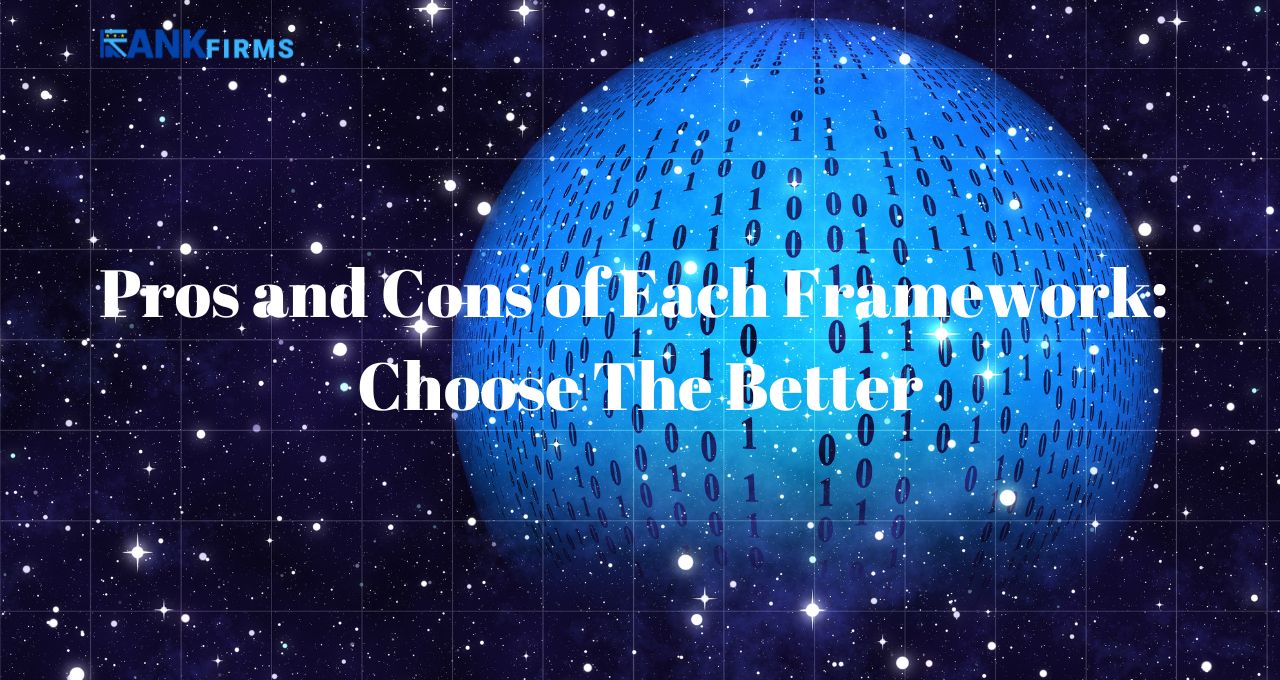Developers are continuously creating new and high-performing frameworks and favoring them over older ones to address the evolving needs of modern software development. These new frameworks offer significant performance enhancements, enabling applications to run faster and handle more complex tasks efficiently. As user expectations for speed and responsiveness rise, these improvements are crucial.
Additionally, modern frameworks come equipped with advanced features and tools that streamline the development process. They often integrate seamlessly with other contemporary technologies, reducing the amount of boilerplate code and increasing developer and software development companies’ productivity. Security is another critical area where new frameworks excel. They incorporate the latest security best practices and protocols, helping developers build secure applications that can withstand emerging threats.
The developer experience is also significantly improved with newer frameworks. Enhanced documentation, active communities, and user-friendly interfaces make these frameworks easier to learn and use, leading to quicker development cycles and higher-quality code. Furthermore, they are designed with scalability and flexibility in mind, allowing applications to grow and adapt to increased demand and changing requirements.
Framework Usage Statistics
To provide context on the popularity and adoption of various frameworks, here are some recent statistics from the web and software development landscape:
- According to the Stack Overflow Developer Survey 2023, the most commonly used web frameworks are React.js, with 42.62% of developers reporting usage, followed by jQuery at 28.82%, and Angular at 24.64%.
- For backend development, Node.js leads with 36.19%, followed by Django at 14.99%, and Flask at 11.78%.
- The JetBrains State of Developer Ecosystem 2023 report highlights that among Python developers, Flask is used by 47% and FastAPI by 14%, showing significant growth in FastAPI’s adoption.
- GitHub’s Octoverse 2023 report indicates that the fastest-growing open-source projects include FastAPI, which has seen a significant rise in contributions and usage.
In this evolving landscape, two standout technologies are making a significant impact: Flask and FastAPI. These frameworks are designed to deliver high-quality, high-performance projects, each offering unique strengths that cater to different aspects of web and application development. Flask is renowned for its simplicity and flexibility, making it ideal for small to medium-sized applications. FastAPI, on the other hand, is celebrated for its speed, efficiency, and ability to handle large-scale applications, especially in the realm of APIs.
In this article, we will delve deeper into these two technologies, exploring how IT services companies can leverage these technologies to revolutionize the development process and redefine the standards of quality and performance in web and application development. We’ll examine their features, benefits, and practical use cases, highlighting how they can be leveraged to build secure, scalable, and high-performing software solutions.
Choosing the Right Framework
Choosing the right framework for development is crucial because it impacts the performance, scalability, security, and maintainability of your application. The right framework can streamline development, reduce costs, and ensure that your application can handle growth and evolving requirements. Additionally, frameworks with strong community support provide valuable resources for troubleshooting and implementing best practices. This foundational decision affects every aspect of your project, making it essential to select a framework that aligns with your specific needs and goals.
Before selecting a framework, it’s essential to understand the core features, benefits, and use cases of each option. This understanding will enable you to make a more informed decision for your next project.
Understanding Flask Framework
Flask, a micro web framework written in Python, is renowned for its simplicity, flexibility, and ease of use. While Flask offers a minimalist approach to web development, it provides robust features and capabilities that make it a preferred choice for website development companies.
Features of Flask:
Minimalistic:
Flask is lightweight and unopinionated, allowing developers to have fine-grained control over their projects without imposing unnecessary constraints.
Extensible:
Flask offers a modular design, allowing developers to add extensions as per their needs. This flexibility enables the integration of various third-party libraries and tools seamlessly.
Routing:
Flask provides a built-in routing system that maps URLs to view functions, making it easy to define routes and handle different HTTP requests.
Template Engine:
Flask offers Jinja2, a powerful and designer-friendly template engine, for generating HTML pages dynamically. This enables developers to create dynamic web pages with ease.
HTTP Request Handling:
Flask provides a request and response object for handling HTTP requests and responses, giving developers full control over the request lifecycle.
Built-in Development Server:
Flask comes with a built-in development server, making it easy to test and debug applications during the development phase.
Benefits of Flask:
Simplicity:
Flask’s minimalist design and intuitive syntax make it easy for developers to get started with web development. Its simplicity reduces the learning curve, allowing developers to focus on building functionality rather than dealing with complex frameworks.
Flexibility:
Flask’s modular architecture and extensive ecosystem of extensions give developers the flexibility to tailor their applications to their specific requirements. This flexibility makes Flask suitable for a wide range of projects, from small prototypes to large-scale applications.
Community and Documentation:
Flask has a vibrant community of developers who contribute plugins, extensions, and tutorials. The extensive documentation and community support make it easy for developers to find solutions to their problems and stay updated on best practices.
Scalability:
While Flask is well-suited for small to medium sized projects, it can also scale to handle larger applications with ease. With proper architecture and design, Flask applications can be scaled horizontally or vertically to meet growing demands.
Compatibility:
Flask is compatible with various databases, web servers, and WSGI servers, allowing developers to choose the technology stack that best suits their needs. This compatibility makes it easy to integrate Flask with existing systems and infrastructure.
Also Read: How to choose the right website development company?
Practical Use Cases of Flask:

Web Applications:
Flask is ideal for building web applications of any size, from simple websites to complex web portals. Its simplicity and flexibility make it suitable for rapid prototyping and iterative development.
API Development:
Flask’s lightweight nature and robust features make it an excellent choice for building RESTful APIs. Its built-in support for request handling, routing, and serialization simplifies API development and maintenance.
Microservices:
Flask’s modular design and extensibility make it well-suited for building microservices architectures. Developers can create small, independent services using Flask and then integrate them into larger systems using APIs or message queues.
Prototyping:
Flask is commonly used for prototyping and proof-of-concept projects due to its simplicity and ease of use. Developers can quickly create functional prototypes using Flask and then iterate on them based on user feedback and requirements.
Educational Projects:
Flask is often used in educational settings to teach web development concepts and Python programming. Its straightforward syntax and clear documentation make it an excellent choice for beginners learning web development.
Flask’s simplicity, flexibility, and robust features make it a versatile framework for building web applications, APIs, microservices, and more. Its minimalist design and extensive ecosystem of extensions provide developers with the tools they need to create scalable, maintainable, and high-performance applications. Whether you’re a beginner learning web development or an experienced developer building enterprise-level systems, Flask offers the simplicity and power needed to bring your ideas to life.
Understanding FastAPI Framework

FastAPI is a modern, high-performance web framework for building APIs with Python 3.6+. It combines the ease of use and simplicity of Python with the performance and scalability required for modern applications, making it a preferred choice for mobile app development companies seeking to streamline their development workflow.
Features of FastAPI:
Asynchronous Support:
FastAPI leverages asynchronous programming to handle high concurrency and I/O-bound operations efficiently. This allows applications to handle multiple requests concurrently without blocking, resulting in improved performance and responsiveness.
Automatic Documentation:
FastAPI generates interactive API documentation automatically based on function annotations and type hints. This feature simplifies API development and maintenance, as developers can easily visualize and test their APIs without additional tooling.
Data Validation and Serialization:
FastAPI provides built-in support for data validation and serialization, ensuring that incoming requests are validated against predefined schemas before processing. This helps prevent errors and security vulnerabilities by ensuring that only valid data is processed by the application.
Dependency Injection:
FastAPI supports dependency injection, allowing developers to define and inject dependencies into their endpoint functions easily. This promotes modular and testable code by decoupling business logic from external dependencies.
Type Checking:
FastAPI performs static type checking based on Python type hints, enabling developers to catch type-related errors early in the development process. This improves code reliability and maintainability by reducing the likelihood of runtime errors.
Performance:
FastAPI is designed for high performance, with benchmarks showing comparable performance to Node.js and Go. Its efficient request handling and low overhead make it suitable for building high-traffic APIs and microservices.
Benefits of FastAPI:
Productivity:
FastAPI’s intuitive syntax and automatic documentation generation streamline the development process, allowing developers to build APIs quickly and efficiently. Its support for asynchronous programming also enables developers to write non-blocking code more easily, further enhancing productivity.
Safety and Reliability:
FastAPI’s built-in data validation and type checking features help prevent common errors and security vulnerabilities, ensuring that APIs are robust and reliable. By catching errors early in the development process, FastAPI helps developers build safer and more secure applications.
Scalability:
FastAPI’s support for asynchronous programming and high-performance request handling makes it well-suited for building scalable APIs and microservices. Its ability to handle high concurrency and I/O-bound operations efficiently ensures that applications can scale to handle increased traffic and workload.
Community and Ecosystem:
FastAPI has a growing community of developers who contribute plugins, extensions, and tutorials. The extensive ecosystem of third-party libraries and tools enhances FastAPI’s capabilities and provides developers with additional resources for building and deploying applications.
Practical Use Cases of FastAPI:
API Development:
FastAPI is primarily used for building APIs, ranging from simple CRUD (Create, Read, Update, Delete) operations to complex data processing and analysis. Its automatic documentation generation and data validation features make it ideal for building RESTful APIs that are easy to use and maintain.
Microservices:
FastAPI’s support for asynchronous programming and high-performance request handling makes it well-suited for building microservices architectures. Developers can create small, independent services using FastAPI and then integrate them into larger systems using APIs or message queues.
Real-time Applications:
FastAPI’s support for asynchronous programming makes it suitable for building real-time applications, such as chat applications, streaming services, and interactive dashboards. Its efficient request handling and low latency ensure that real-time data updates are delivered quickly and reliably to clients.
Machine Learning APIs:
FastAPI is commonly used for building APIs that expose machine learning models and algorithms. Its support for automatic documentation generation and data validation simplifies the process of exposing machine learning capabilities as RESTful APIs, allowing developers to deploy and integrate models more easily into their applications.
Also Read: 10 Factors to choose the best mobile app development company
FastAPI’s combination of performance, productivity, and safety makes it a compelling choice for building APIs and microservices with Python. Its support for asynchronous programming, automatic documentation generation, and built-in data validation features enable developers to build scalable, reliable, and high-performance applications with ease. Whether you’re building APIs for web applications, microservices architectures, or machine learning models, FastAPI provides the tools and capabilities needed to bring your ideas to life quickly and efficiently.
Pros and Cons of Each Framework: Choose The Better

| Aspect | Flask | FastAPI |
| Ease of Use | Simple and easy-to-learn syntax. | Intuitive syntax with automatic documentation generation. |
| Performance | Moderate performance, suitable for small to medium-sized applications. | High performance, comparable to Node.js and Go. |
| Asynchronous Support | Limited support for asynchronous programming. | Full support for asynchronous programming, enabling high concurrency and I/O-bound operations. |
| Documentation | Extensive documentation and active community support. | Automatic API documentation generation based on function annotations and type hints. |
| Flexibility | Highly flexible, allowing developers to structure applications as they see fit. | Flexible, with support for dependency injection and modular design. |
| Data Validation | Requires manual implementation for data validation. | Built-in support for data validation and serialization. |
| Dependency Injection | Limited support for dependency injection. | Supports dependency injection, promoting modular and testable code. |
| Learning Curve | Low learning curve, suitable for beginners. | Moderate learning curve, especially for developers new to asynchronous programming. |
| Scalability | Scalable for small to medium-sized applications. | Highly scalable, suitable for building large-scale applications and microservices architectures. |
| Community | Large and active community with a wealth of resources. | Growing community with increasing adoption and contributions. |
To Conclude –
Flask is well-suited for beginners and small to medium-sized applications due to its simplicity and flexibility. FastAPI, on the other hand, offers high performance, asynchronous support, and automatic documentation generation, making it ideal for building large-scale applications and APIs that require high concurrency and I/O-bound operations. Your choice between Flask and FastAPI should depend on your project requirements, familiarity with asynchronous programming, and preference for performance and scalability.







